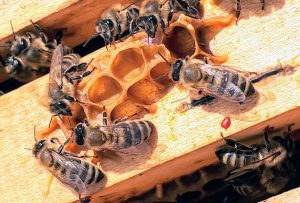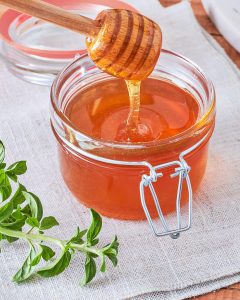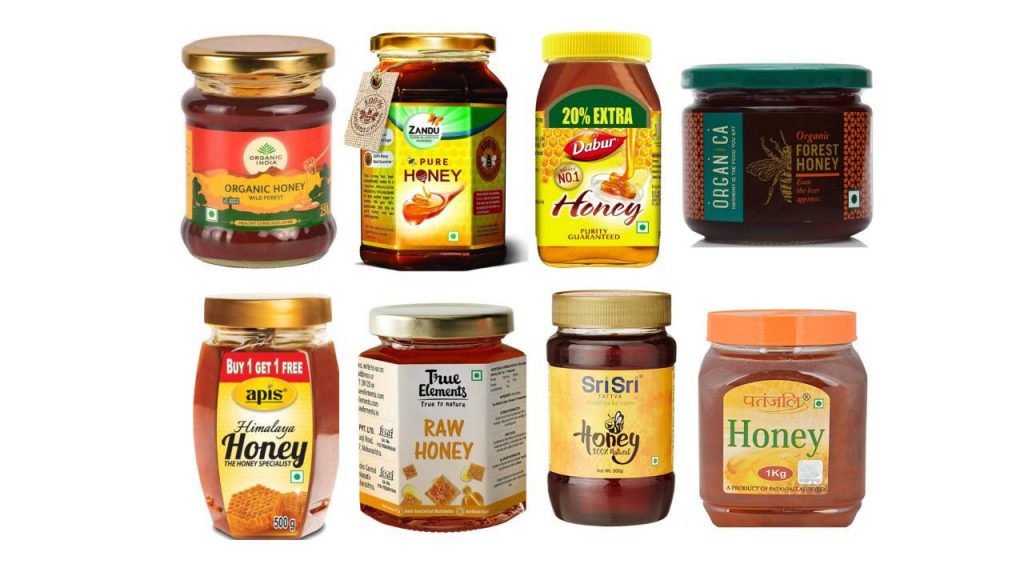The type of floral nectar the bees used to make honey with also determines the speed at which the honey will crystallize. The glucose and fructose level of honey also depends on the type of flower the bees fed on. Now, as the glucose content is what leads to crystallized honey, some honeys are resistant to crystallization because they have low glucose levels while some have faster crystallization rate.

3. Storage conditions of honey
Temperature, humidity, and type of container used to store the honey play a big role in how fast honey will crystallize.
Types Of Honey Crytallization
You must have noticed how different brands of honeys have a different type of crystallization process. Let’s have a look at the different types of Honey Crytallization. The size of the crystals can be either fine, or chunky. The honey can be partially or fully crystallized depending on the storing conditions. The speed at which honey crystallizes also determines the size of the grains. Honey that crystallizes rapidly will have a finer texture. The longer it takes, the grainer the texture.
Is Crystallized Honey Edible? Has The Crystallized Honey Gone Bad?
We have often been asked the question if crystallized honey is safe to eat? Crystallized honey is 100% edible. Yes, the texture of the honey might have changed but it does not mean that it is not safe to eat. In fact, some people prefer crystallized honey because it is easier to spread/use on a toast and doesn’t drip. So go ahead and add some honey-licious goodness in your life. Further in the article, we have suggested a few ways you can use crystallized honey.
Is Pollen In Honey Normal?
Yes. Pollen in honey is normal. The amount of pollen in honey is very little and does not affect the nutritional value. Raw honey contains pollen in higher amounts in comparison to processed honey.
That being said, the presence of pollen can indicate the type of nectar or type of flower the bee fed on to produce the honey. It has been found that raw honey might also contain been venom, bee parts, and bacteria too. If the honey is pollen less, you cannot track the type of flower that the bees used to make honey. You can read more about raw honey, how is it different from processed honey in detail here.
Crystallized Honey – Does The Nutritional Value Of The Honey Change?
Absolutely not. On the contrary, the crystallization process of honey keeps the nutrients and flavor intact. But yes, if you heat the honey the flavor and aroma will be altered. Repetitive heating of honey is not recommended.
Can You Prevent Honey From Crystallizing?
The right storage of honey is vital. If you store your honey correctly, the crystallization process will surely slow down. If your honey is unfiltered and completely raw, the crystallization process will speed up even more. Avoid storing your honey in the fridge, as it will accelerate the process. Storing your honey at room temperature or the ‘warmer’ room is better to reduce the speed of crystallization. It is also preferable to keep honey in glass jars instead of plastic ones to help keep moisture at bay.

Can You Fix Crystallized Honey?
Yes, you can. If you do not like the look of crystallized honey and want it to go back to its liquid state again, there are a number of ways to do it. But, be warned; heating the honey at high uneven temperatures will put the nutrients and flavor at risk.
Warm water bath is the perfect answer if you want to liquidize your honey. The best and safest possible method to liquidize your honey is to soak the bottle in warm water at a regulated temperature. This might take anywhere between 10 minutes to 1 hour depending on the weather outside. Make sure you don’t use hot water for this. If you want to do it quickly, you can microwave it too – though this is not highly recommended as it can hurt the nutritional value of honey. If you are reheating the honey, use a glass pot / bottle instead of plastic bottle.
Boiling honey is a disaster, never do that. Liquifying your honey, again and again, is also a big no-no. Repeated heating and cooling of honey eventually will highly increase the chances of losing the natural flavor and aroma of honey.
How To Use Crystallized Honey?
Crystallized honey tastes delicious. Here are some ways for using crystallized honey –
- Using it to spread on a simple warm toast. Warm toasted bread smeared with crystallized honey tastes brilliant.
- Replace sugar with crystallized honey in tea. The crystals will melt the moment they meet the hot tea.
- Use it as a beauty product for locking in moisture for skin and hair. Adding crystallized honey to your DIY face packs and hair masks will ensure beautiful results.
- Crystallized honey is easily the best thing to add to your morning cereal bowl.
- Make energy bars at home with crystallized honey is a really great idea and taste delicious.
- If you are making a kaadha, adding a teaspoon of honey will amp up it’s immunity boosting abilities.
 Multiple brands of honey
Multiple brands of honeyFrequently Asked Questions
Here we answered a few FAQs about honey crystallization.
1. Is it safe to eat honey that’s crystallized?
Yes. The sugar content in honey is 80% which is why it is absolutely normal for honey to crystallize. The nutritional aspect of the honey remains unchanged even after crystallization.
2. How long does it take for honey to crystallize?
The crystallization of honey depends on weather conditions. The crystallization process accelerates at a cool temperature. So it is advised to never refrigerate the honey.
In addition, it depends on the floral source used during the production of honey and the chemical composition of honey.
3. Is it OK to microwave crystallized honey?
It is advised not to microwave honey to decrystallize it. As it may destroy beneficial enzymes and change the chemical composition of honey. Instead, a warm water bathing honey bottle to decrystallize is the better and safest option.
4. Can you reverse crystallized honey?
It is advised to never heat the honey. Heating it at an uneven temperature can lead to a loss of nutrients and a change in the flavor of honey. There are two safe methods to liquidize honey.
Keep it in the sun for a few hours. This will help regain the liquid consistency.
The best and safest method to liquidize the honey is by soaking the jar in a warm water bath. This process might take anywhere between 10 minutes to an hour, depending on the weather and temperature of the water. Make sure you don’t use boiling water for this.
It is also advised to never boil the honey. Neither should it be reheated or re-liquified more than once.
Final Words
It is concluded that honey crystallises. The crystallisation process in honey is natural. The crystallised honey is safe to eat. When the honey is crystallised dont throw it away instead keeps the jar of honey in the warm water for a few minutes. Once done, honey is safe to consume as it is pasteurized now.
Let us know in the comment section, what you do with the crystallised honey?




